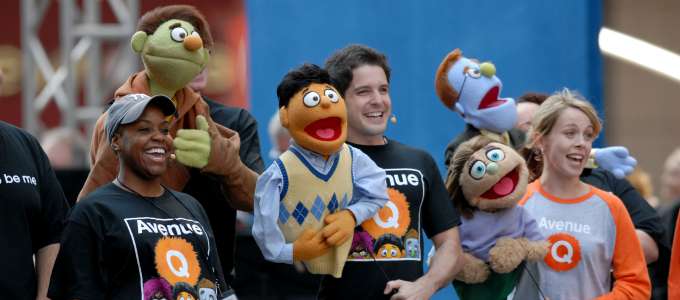The cast of "Avenue Q" performs at a promotional event. (Courtesy of Wikimedia Commons)
Funny how certain songs have a knack for burrowing into our brains at appropriate times. For me, it’s recently been a little ditty from Tony Award-winning musical “Avenue Q” called “Everyone’s a Little Bit Racist.”
The show is an R-rated version of “Sesame Street,” featuring characters played by both live actors and puppets who endure adult life’s hard knocks, including relationships, sex, careers and dashed dreams. Time hasn’t been kind to the show’s details — some of its jokes revolve around George W. Bush’s presidency, and one of the characters is the late Gary Coleman — but its themes endure, particularly those around racism.
“Everyone makes judgments based on race,” main characters Kate and Princeton sing. “Not big judgments like who to hire or who to buy a newspaper from, but little judgments like thinking that Mexican bus boy should learn to speak English.”
Writers Jeff Marx and Robert Lopez were partially right. Instead of calling it racism, let’s call it bias-ness — we’re all naturally partial to things that are familiar to us, from those who share our same characteristics to where we like to go out to dinner for special occasions.
Heidi Grant Halvorson, director of the diversity and bias practice at the NeuroLeadership Institute, said unconscious bias is a natural setting in our minds that makes us gravitate toward people and ideas that are like us.
In business, it not only affects workplace diversity — hiring managers recruit those who look like the existing workforce — but also decision-making, such as which projects to prioritize, who to assign to an account or who to promote. When a business plan starts dragging down a company, a new CEO is more likely to get rid of it than the executive who created it.
The problem isn’t that bias exists but how learning leaders have tried to handle it, mostly because it’s impossible to see a change simply by building awareness.
“It’s like I did a three-hour training on the pancreas, and then said ‘Now that you know so much about your pancreas, change how much insulin it’s making,’ ” Halvorson said.
It’s also important to clarify that unconscious bias does not make us awful people. Our biases have been handed down from our ancestors, who had to be able to identify and associate with their own tribe during the hunter-gatherer days.
“It makes sense when the priority is to stay alive, but it doesn’t make sense for people in the first world,” Halvorson said. “It really becomes about finding strategies you can use that are systematic.”
She gave a few practices and strategies CLOs can promote within an organization to help people work around their unconscious biases:
- Remove names and graduation date from résumés before they get to a hiring manager so that there’s no indication of the applicant’s gender, ethnicity and age.
- Diverse groups might have trouble working together because there’s an “us vs. them” mentality that comes from unconscious bias. As elementary-school as it sounds, team names offer a common factor everyone can share. The brain won’t be as distracted by “He’s black” or “She’s only got an associate’s degree” because it’ll be more focused on “We’re all on Team Avenue Q.”
- Bias occurs between departments, too. An IT department might be asked to work with the finance team, and there will be friction because they cognitively see the groups as different. Emphasize the term “we” to avoid the bias created by siloes. It’s not “we” the editorial team, but “we” the company.
“Stop telling people they’re above (unconscious bias),” Halvorson said. “We need to integrate these strategies into how organizations run and how decisions are made.”











